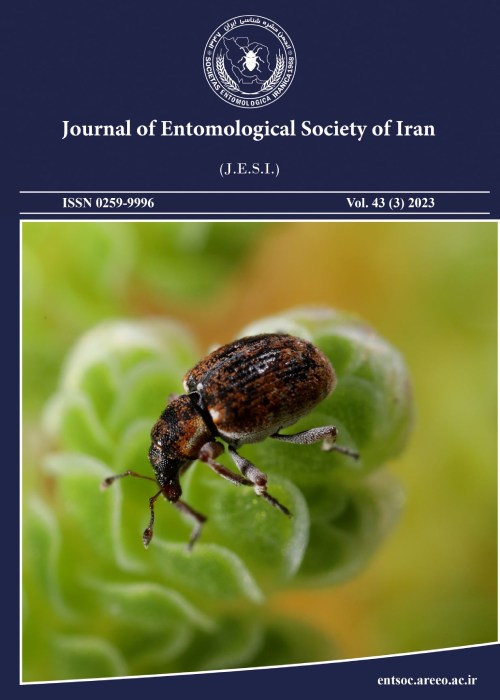Influence of drought and temperature on population density of two species of spider mites and their predator Scolothrips longicornis in almond orchards
Author(s):
Article Type:
Research/Original Article (دارای رتبه معتبر)
Abstract:
High temperatures and low-humidity are the favorable conditions for spider mites, Tetranychus urticae Koch and Schizotetranychus smirnovi Wainstein, to cause serious threat to quality and quantity of almond. This study was undertaken to understand population changes of the spider mites during the normal and dry years and to predict the possibility of the pest outbreak in order to develop a successful integrated management strategy. Population fluctuations of S. smirnovi and T. urticae were studied on almond (Mamaei variety), from April to October of 2007-2009, in Saman orchards, Chaharmahal va Bakhtiari province, Iran. Meteorological data of three nearest synoptic stations including Saman, Zaman khan and Shahre-kord were collected from the Chaharmahal va Bakhtiari meteorological organization. The Standardized Precipitation Index (SPI) was used to detect meteorological droughts based on the monthly rainfall input data of three synoptic stations. The results showed the year 2008 as an extremely dry year, while revealing 2007 and 2009 as normal years. Comparison of spider mite population density in this year (SPI < -2) with the normal years, 2007 (SPI = -0.53) and 2009 (SPI= 0.41), showed a significant increase in the population density of, S. smirnovi, (14.65 and 2.95 times) and T. urticae (7.28 and 2.87 times) compared to 2007 and 2009, respectively. Spearman’s correlation analysis showed significant negative correlation of mean precipitation with population density of, S. smirnovi, (r = -0.65, p=0.022), T. urticae (r = -0.73, p=0.0001), and the predatory thrips, Scolothrips longicornis Priesner, (r = -0.67, p=0.0001) during three studied years. In the drought year, the phytophagous mite’s population increased in response to high temperatures and low humidity. In a such year, the almond trees can be more vulnerable to mite damages and control is necessary.
Keywords:
Language:
Persian
Published:
Journal of Entomological Society of Iran, Volume:42 Issue: 3, 2023
Pages:
173 to 182
magiran.com/p2529617
دانلود و مطالعه متن این مقاله با یکی از روشهای زیر امکان پذیر است:
اشتراک شخصی
با عضویت و پرداخت آنلاین حق اشتراک یکساله به مبلغ 1,390,000ريال میتوانید 70 عنوان مطلب دانلود کنید!
اشتراک سازمانی
به کتابخانه دانشگاه یا محل کار خود پیشنهاد کنید تا اشتراک سازمانی این پایگاه را برای دسترسی نامحدود همه کاربران به متن مطالب تهیه نمایند!
توجه!
- حق عضویت دریافتی صرف حمایت از نشریات عضو و نگهداری، تکمیل و توسعه مگیران میشود.
- پرداخت حق اشتراک و دانلود مقالات اجازه بازنشر آن در سایر رسانههای چاپی و دیجیتال را به کاربر نمیدهد.
In order to view content subscription is required
Personal subscription
Subscribe magiran.com for 70 € euros via PayPal and download 70 articles during a year.
Organization subscription
Please contact us to subscribe your university or library for unlimited access!


